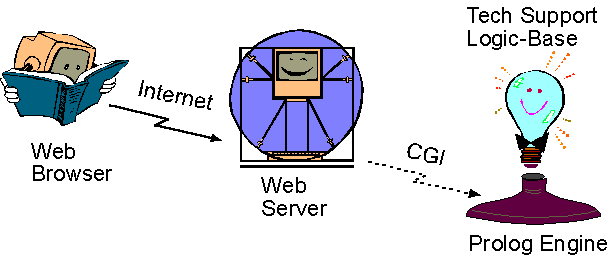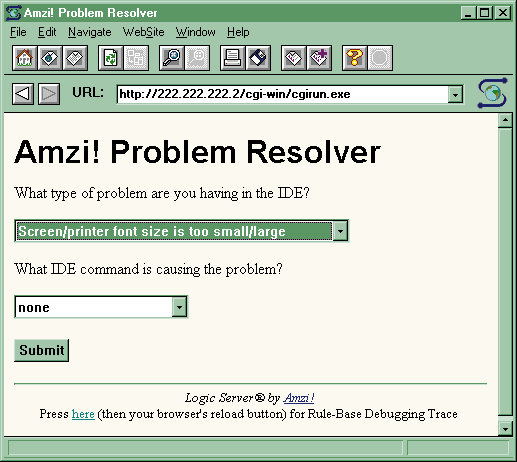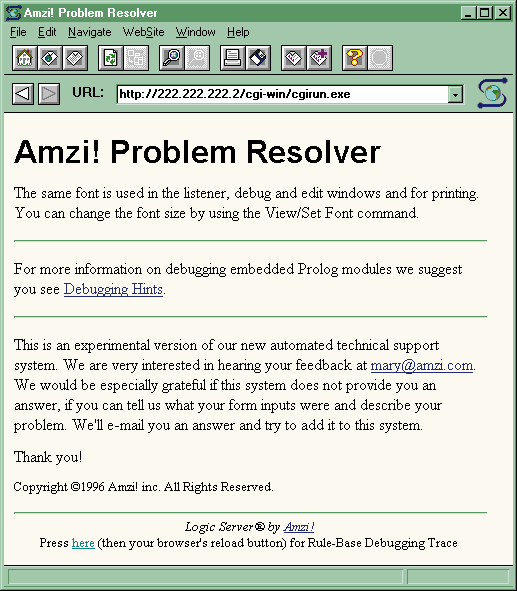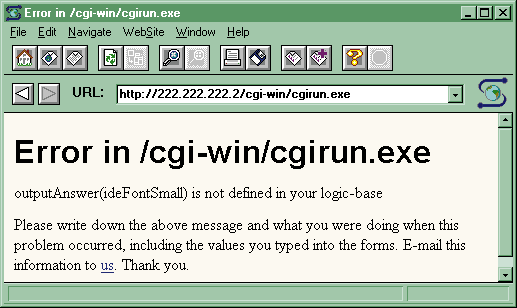
Figure 1: WebLS Architecture
This is an expanded version of an article that appeared in Dr. Dobb's Sourcebook, Sep/Oct 1996.
As user of software, one of the primary reasons I use the web is for technical support. As a vendor of software, I would like to provide my users with the answers they need in the most timely and efficient manner possible.
But search engines, technical notes and FAQs really just scratch the surface of what is possible on the web. HTML has all the necessary tools to gather information from the user and present solutions. The missing piece is a logic-base to tie it all together intelligently and efficiently.
This article presents a system, called WebLS (pronounced webbles), that answers commonly asked technical support questions. WebLS is implemented using the CGI interface. The logic-base is implemented with the Amzi! Logic Server which uses the industry-standard language Prolog. However, nothing here is specific to the Amzi! implementation. The concepts can be implemented in other Prologs or even in other languages (although we think you'll find Prolog ideally suited to building logic-bases).
Our goal is to build and maintain an on-line tech support system that can answer most new user's questions, clear up existing user's common misunderstandings, clarify documentation deficiencies and report known bugs and their workarounds. There are two sets of requirements to fill: the user's and the developer's.
Users need to be able to access on-line technical support using any web browser. The questions need to be kept to a minimum and be easy to answer: multiple choice, yes/no and fill-in-the-blanks.
The answer needs to be complete and point to any additional resources needed to resolve the problem (such as the location of a patch file, sample code, etc.)
The system needs to be available on many different web servers. Although Netscape and Microsoft are introducing APIs for communicating directly with web servers, CGI is currently the only common standard. However, because the CGI interface fires off a program each time a form is submitted, we need to minimize the number of times this happens.
Another requirement is that the state of the dialog needs to be maintained throughout the information gathering process with the user. As multiple users will be using on-line tech support simultaneously, the state for each of them must be kept separately. (Netscape's 'cookies' could be used for this purpose but as cookies are not yet widely supported, a different approach is used.)
Finally, and most importantly, a tech support database will only be useful if it can be kept up-to-date. And it can only be kept up-to-date if the rules in the logic-base are easy to maintain. In addition, the logic-base needs to take advantage of existing resources, such as other on-line documents, pictures, databases, search engines, etc.
WebLS fills the above requirements by integrating a logic-base with the CGI interface and HTML.

Figure 1: WebLS Architecture
HTML forms are ideal for gathering information from the user. Multiple pieces of information can be gathered at the same time. HTML documents can be constructed a piece at a time. And, most importantly, they can readily point to other resources, such as other documents, a particular place in another document, other files, directories of files, etc.
A logic-base ties everything together. It contains facts gathered from the user, and rules to determine the problem from the facts. The rules are easy-to-read and declarative so they are easy to maintain. The logic-base knows about related facts so it can batch questions together (to reduce the number of CGI invocations).
For WebLS, Prolog is used to construct and execute the logic-base. We use Prolog's ability to define new operators to implement the rule language, and its powerful, built-in search and pattern matching capabilities to determine which rules to use in a given situation. These features make Prolog an ideal choice for implementing custom logic-bases.
Before we get into how WebLS works, lets take a look at a problem resolution session for an Amzi! user.
First, general information about the user's environment and the problem area is gathered from the user with HTML forms. In this case the problem is in the IDE (Interactive Developer's Environment).

Figure 2: An Initial HTML Form for Tech Support
Next, a short dialog takes place between the user and the system in order to narrow down the problem and gather specific details. In this case, the problem is the printer font size is too small.

Figure 3: Tech Support Dialog
Once the problem has been determined an answer is presented. The answer can be a couple of paragraphs, or it can be another web document. In this case, a couple of sentences describes how to change the font size.

Figure 4: A Problem Resolution
A logic-base in WebLS consists of:
Facts are gathered from the user, or distilled from other facts. Examples of facts are: the error message, the program version, and the operating system. Rules are of the form if-then and check the values of facts to determine the problem. Methods define how to perform input and output using HTML.
Facts are stored in the logic-base as attribute-value pairs. For example: the 'environment' attribute has the value 'Windows 95', the 'programName' attribute has the value 'Amzi! IDE'.
For each fact that can be obtained from the user, a method needs to be defined for asking it. WebLS implements three methods using HTML form components. They are:
Below is an example of each. This is how we ask for the 'errorCode'
attribute. The 5 is the HTML form field length and dollar signs
($) are used to delimit strings.
attr(errorCode, [ prompt = $What error code was displayed or 'none'?$, ask = field, length = 5 ]).
This is how we ask for a value from a list. The square brackets
are used to bracket the list of choices.
attr(environmentNameVer, [ prompt = $What environment are you running under?$, ask = menu(['Windows 3.x', 'Windows 95', 'Windows NT', 'DOS', 'Linux']) ]).
This is how we ask a yes/no question.
attr(usingDCG, [ prompt = $Are you using DCG in your Prolog module?$, ask = yes ]).
Some facts WebLS does not ask the user for values for. Instead they are distilled from other facts. Usually this is done to group a set of related facts together. An example of a distilled fact is 'language', which has the value 'C/C++' if the fact 'languageTool' has any one of these values: 'Visual C++', 'Borland C++', 'Watcom C++', etc.
In order to reduce the number of interactions with the user, the logic-base supports the concept of related facts. Entirely optional, they allow you to specify what facts are related. It lets you 'group' facts together, so all the facts for a particular hypothesis can be gathered in a single form.
Here is how related facts are specified:
attr(ideCommand, [... related = [ideProblemType, amziVersion] ... ]).
This says that 'ideProblemType' and 'amziVersion' are related to 'ideCommand'. When the rules are executed, if WebLS is going to ask the user for ideProblemType, it will also ask for the other two facts as well.
The heart of the logic-base is the rules. Rules can either directly
determine the problem, or they can determine other facts (distilled
facts). Here is a simple rule:
if errorMessage = 'Code too long to load' then problem = srcbufTooSmall.
It says if the attribute 'errorMessage' has the value specified then the problem is 'srcbufTooSmall'. Now there is nothing particularly difficult or remarkable about this rule, nor is there about most of the rules in WebLS. What is notable is that the rules are easy to read and can appear in the logic-base in any order. This makes is easy to maintain logic-bases with hundreds of rules. A Prolog 'inference engine' (that's a fancy way to say search and pattern matching engine) scans the rules looking for ones that 'succeed.' A rule is said to succeed when all of the facts on the 'if' side match correctly.
Before we examine the inference engine, lets look at some more
rules and how answers are outputted.
if languageTool = 'Visual C++' or languageTool = 'Borland C++' or languageTool = 'Watcom C++' then language = 'C/C++'.
This rule distills the fact 'language' from the user-provided
fact 'languageTool'. This allows us to simplify rules such as
the following:
if language = 'C/C++' and
apiFunction = 'lsInit' and
( (errorMessage = 'GPF (General Protection Fault)' and
environmentNameVer = 'Windows 3.x') or
environmentNameVer = 'DOS' )
then problem = cLargeModelRequired.
Note here that more of the power of the rule language becomes evident. We can use 'and', 'or' and parenthesis to check facts. Also, not shown here, is the ability to check if an attribute is 'not equal' to a particular value.
Notice that rules that have determined an answer end with 'problem='. The logic-base has one final piece, that is outputting the answer associated with the problem.
For each fact in the rule-base we had to define how to obtain its value. Similarly for every problem, we have to define how to output the answer. WebLS offers three options, the first two of which can be used in combination:
Lets look at some examples. First outputting HTML text:
answer(cLargeModelRequired,
[
text = [$16-bit C/C++ applications require the large memory model. $,
$Failure to use it leads to immediate GPFs.$]
]).
This answer is outputted when the problem is 'cLargeModelRequired'. The dollar signs are used around strings in the logic-base, and the square brackets are used around lists. So this answer is a list of two strings.
If you would rather keep the answers in separate HTML documents,
you can send them out as shown in this example:
answer(lsxNotLoaded, [ htmlFile = 'lsxintro.htm' ]).
The third approach is to redirect the user to another document.
This lets you keep your answers in searchable, browseable documents
and use tags to direct the user to the right place. For example:
answer(componentNotInstalled, [ url = 'http://www.amzi.com/install#delphi_component' ]).
Now that we've described the contents of a logic-base, we can examine how it is executed. We mentioned before that an 'inference engine' is used to execute the rules. The inference engine in WebLS is written in Prolog. In fact many of the structures described above that form the logic-base use Prolog components such as strings and lists. The core of the search and pattern matching engine is accomplished in about 35 lines of Prolog code. Here is what it does:
Lets examine these steps in some detail.
The initial form is used to gather as much information as possible (without overwhelming the user) to determine a general direction to search for the answer. In Amzi!'s system, we ask for the error message because often it is possible to determine the problem directly from the message alone.
The Prolog-CGI interface reads the form values from the CGI input
file and asserts the facts in the logic-base. The initial form
is designed such that the attribute names are simply taken from
the name of the form field. For example:
<INPUT NAME="errorCode" TYPE="TEXT" VALUE="none" ROWS=1 SIZE="10" ALIGN=left>
This gets the value for the attribute 'errorCode'.
WebLS writes the initial form to the CGI output file and exits. When the submit button (on the form) is pressed by the user, WebLS is started again and the form values are sent to it via the CGI interface.
When WebLS starts again it reads the form values entered by the user and asserts the facts to the logic-base. Next, we run the logic-base to see if a rule can be found, whose facts are all known, and whose values match the criteria specified in the rule. To do this, the inference engine starts with the first rule in the logic-base and continues to examine the rules until one is found or there are no more rules. If the problem was identified, the answer is outputted for that problem and we proceed to the clean-up phase.
If the problem is not found, then we enter a dialog with the user to gather more information.
To build the next form, we search the logic-base again. This time we look for the first rule whose known facts all match, and make a list of the unknown facts. For each unknown fact, its attr(...) definition is used to output the question to the HTML form. Also for each unknown fact, any and all related facts are also asked. The resulting form will be returned to the web server to be displayed to the user.
Before WebLS exits, the facts we already know are saved to a file. The name of the file is generated using a random number and is hidden in the submit button of the form we built above.
When WebLS is started again, it picks up the name of the fact file from the submit button. It combines the new facts from the user with the facts we already knew and checks for an answer again. This process repeats until we find the problem or run out of hypotheses.
Finally we delete the fact file that we were saving the known facts in. We also delete any fact files that are more than an hour old. This is necessary because they will be left around when a user aborts out of a question-answer session.
In general you will find that logic-bases for technical support are 'flat'. This means that most rules won't depend on multiple layers of distilled facts. So debugging the rules is generally straight-forward.
WebLS includes a trace facility to assist in testing and debugging logic-bases. The trace lists all the known facts, and then shows each rule being tried, indicating which facts match, and which rule or hypothesis matches. When tracing is enabled, a URL pointing to the output is included on each page generated by WebLS. This allows you to examine the trace directly in your browser.
A typical debugging session has you fill-in the answers on the form (in the same manner your users would), then see the trace to determine how the answer was reached, or why another set of facts is being asked for.
Below is a small logic-base and the trace of a particular run.
% ------------------------------------------------------------------- %
% The Rule-Base %
% ------------------------------------------------------------------- %
%
% Required definitions for Amzi! Do not change or remove.
%
:- op(790, fx, if). % prefix operator
:- op(780, xfx, then). % infix operator
:- op(775, xfy, or). % infix that can be linked
:- op(770, xfy, and). % infix that can be linked
:- op(700, xfx, <=). % infix operator
:- op(700, xfx, include). % infix operator
system('Log File', 'C:\\AmziCGI\\logs\\lilrun.htm').
system('Results Files', 'C:\\AmziCGI\\logs\\results.pro').
system('Title', $Amzi! Problem Resolver$).
system('Initial Form', $C:\\AmziCGI\\html\\testprob.htm$).
system('AmziCGI Directory', $C:\\AmziCGI$).
system('Form Action', 'Executable Path').
system('Goal', 'problem').
attr(errorCode,
[
prompt = $What error code was displayed or 'none'?$,
ask = field,
length = 5
]).
attr(programType,
[
prompt = $What program are you running?$,
ask = menu(['other', 'Amzi! Hello Program', 'Amzi! Sample Program',
'Amzi! IDE', 'My Program', 'Windows Application'])
]).
if errorCode = '600' and
programType = 'Amzi! Hello Program'
then problem = helloXPL.
if errorCode = '600' and
programType = 'Amzi! Sample Program'
then problem = sampleXPL.
if errorCode = '600' and
programType = 'My Program'
then problem = missingXPL.
answer(helloXPL,
[
answer = [$The program is unable to locate the Amzi! Prolog object $,
$module, an XPL file. Make sure the AMZI installation $,
$directory is in your path, and that HELLO.XPL file $,
$exists in the path or the current directory.$]
]).
answer(sampleXPL,
[
answer = [$The program is unable to locate the Amzi! Prolog object module, an XPL file. $,
$Some of the Amzi! samples include source only, $,
$and the PRO file needs to be compiled and linked $,
$into an XPL file.$,
$<P>If the XPL file exists, then it must be in your $,
$path or the current directory.$]
]).
answer(missingXPL,
[
answer = [$The program is unable to locate the Amzi! Prolog object $,
$module, an XPL file. Make sure the the XPL file exists in $,
$your path or the current directory.$,
$Note: Some development environments such as Visual Basic $,
$and Delphi set the current directory to a directory you $,
$might not have expected.$]
]).
You can see in the listing above the three main parts of the logic-base. There are the rules. These are followed by the attr(...) definitions (procedures) and the answer definitions.
Logic-Base Debugging Trace
system($Input File$,$C:\WEBSITE\CGI-TEMP\287WS.INI$).
system('Content File','C:\WEBSITE\CGI-TEMP\287WS.INP').
system('Output File','C:\WebSite\cgi-temp\287ws.out').
. . .
system('Log File','C:\AmziCGI\logs\lilrun.htm').
system('Title',$Amzi! Problem Resolver$).
system('Initial Form',$C:\AmziCGI\html\rptprob.htm$).
system('AmziCGI Directory',$C:\AmziCGI$).
system('Form Action','Executable Path').
system('Goal',problem).
cgi('Content Length','191').
cgi('Content Type','application/x-www-form-urlencoded').
. . .
cgi('Executable Path','/cgi-win/cgirun.exe').
cgi('Request Method','POST').
cgi('Request Protocol','HTTP/1.0').
fact(submitProblem,'Submit').
fact(amziVersion,'3.3 Jan96').
fact(environmentNameVer,'Windows 3.x').
fact(apiFunction,none).
fact(predicate,none).
fact(languageTool,other).
fact(programType,'Amzi! Sample Program').
fact(errorCode,'600').
fact(errorMessage,none).
Processing POST method (subsequent times through)
Opening fact file: submitProblem
---> Calling logic-base for the first time
Trying problem = helloXPL
Trying errorCode = 600
Matching errorCode is 600
Trying programType = Amzi! Hello Program
Failing problem = helloXPL
Trying problem = sampleXPL
Trying errorCode = 600
Matching errorCode is 600
Trying programType = Amzi! Sample Program
Matching programType is Amzi! Sample Program
Matching problem = sampleXPL
---> Logic-base succeeded in finding an answer: sampleXPL
This trace illuminates the 'backtracking' search that is inherent in the Prolog language and implemented in the WebLS inference engine. You can see the first rule matches on the errorCode ('600') but fails on the programType. The second rules matches on both and succeeds; that is, it identifies the problem as 'sampleXPL.'
On-going maintenance of the logic-base is very straight-forward. The Amzi! tech support logic-base is organized by problem area. There is a section based on error message alone, then a section on the Amzi! samples, a section on the Amzi! IDE, a section on Prolog predicates, a section on Logic Server API calls and then sections for each of the tools and languages that Amzi! Logic Servers can be embedded into.
Everytime tech support writes up an answer for a customer, it forwards it to the logic-base developer who incorporates it into the rules in the appropriate section, and then adds the answer(...) definition for the problem. If the rule requires some new facts, attr(...) definitions (or rules) are created for each one.
The most important consideration when adding new rules, is to use related facts lists wherever possible. This reduces the number of interactions with the users, resulting in less frustration for them, and less load on the web server.
When debugging new rules, the trace facility described above is very useful for figuring out which rule succeeds and why. In addition to the trace facility, WebLS reports syntax errors in the logic-base as well as when attr(...) is not defined for a needed fact and when answer(...) is not defined for a reached conclusion. These errors are returned on an HTML error page designed for the purpose.

Figure 7: WebLS' HTML Error Page
WebLS has many possibilities for the future. Some of them will hopefully be implemented by the time this article is published.
The first, and most obvious, is to e-mail unresolved problems to tech support. This e-mail would include the known facts, plus a free-form description of the problem.
It would also be useful to support large fields and fields with special characters that are saved in external files. Large field support would be enhanced by adding an operator 'contains' that checks if the field contains a particular word or phrase. A larger goal would be adding some natural language parsing using knowledge specific to the problem domain. (Prolog is very good at this.)
Another useful feature would be to save each transaction in an external database for later analysis. This would allow tech support managers to keep statistics regarding the use of the on-line system versus other support methods. It can help development managers to identify the areas where users have the most problems. And it can help the logic-base developer to craft better questions.
Along a similar vein, the on-line tech support system could use ODBC (or another means) to connect to, search and retrieve information from an existing tech support system or related database. And the tech support system could save the problems in the customer database so that when a human answers a tech support call, a log of the customer's use of the on-line system is made available.
Finally, the logic-base and inference engine could be shipped
with the product to help new users through the early learning
period as many new users encounter the same problems and have
the same types of questions. Of course, the part shipped with
the product would interface with the full web server-based system.
WebLS is available for downloading free of charge from Amzi!'s web site, http://www.amzi.com. As of this writing, WebLS runs under Windows 95 and NT. Unix versions will also become available. Check the web site for the latest information. WebLS includes full source code, documentation plus some sample logic-bases.
Mary Kroening is a founder of Amzi! inc., and is developing
WebLS and other interfaces between internet resources and the
Amzi! Logic Server. She can be reached on www.amzi.com.